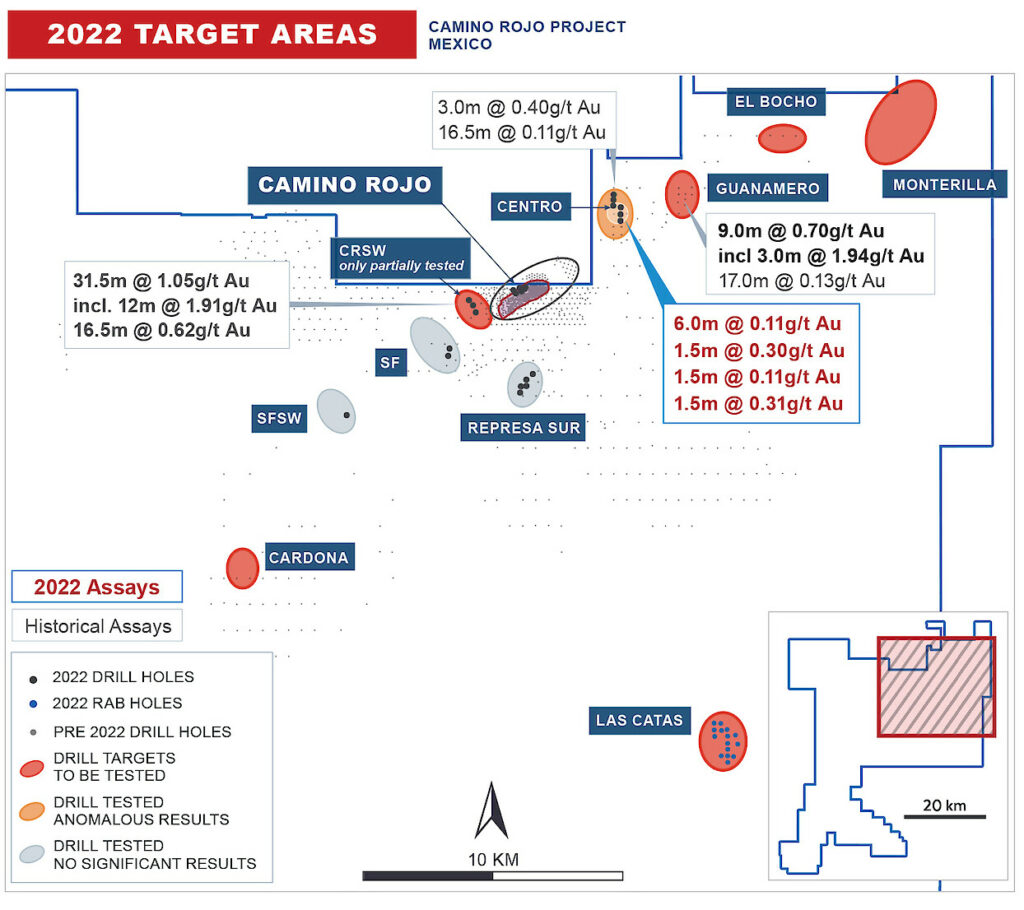Continued Definition of Higher-Grade Zones at Camino Rojo Sulphides
VANCOUVER, BC – September 12, 2022 – Orla Mining Ltd. (TSX: OLA; NYSE: ORLA) (“Orla” or the “Company”) is pleased to provide an update on the Company’s 2022 exploration program including drilling completed in the second quarter of 2022.
“Now in production, we are pleased to have finally begun exploration across our large prospective portfolio covering three countries and 200,000 hectares. Since April, we have been making great strides in advancing our key exploration growth opportunities. Most notably, Phase 2 drilling at the Camino Rojo Sulphides continues to intersect wide, higher-grade mineralization. As a result of the success and prospectivity encountered across the portfolio, we have increased our planned exploration spending in 2022. Exploration is a tenet of our value creation strategy.”
- Jason Simpson, President and Chief Executive Officer of Orla
HIGHLIGHTS:
- Camino Rojo Sulphides (Mexico): Phase 2 drilling continues to return wide, higher-grade intercepts, supporting Orla’s geological model and mineral resource estimate. The recent, south-oriented drilling is providing greater understanding of the geological controls, continuity, and distribution of gold grades versus historical drilling. This new information is proving to be critical in determining the preferred mining option and mine design, which will support the most economic resource extraction method. Intercept highlights include:
- Hole CRSX22-06 : 2.56 g/t Au over 41.5m, incl. 4.00 g/t Au over 19.5m
- Hole CRSX22-08A : 3.08 g/t Au over 52.5m, incl. 4.37 g/t Au over 28.5m
- Cerro Quema – La Pelona Oxides (Panama): The two diamond drill holes completed at this target returned significant widths of oxide-gold mineralization, including 0.27 g/t gold over 113.7m, and 0.46 g/t gold over 104.8m, indicating potential for additional oxide-gold mineralization to expand upon the plan outlined in the Cerro Quema Pre-Feasibility Study (as defined below) (Figure 6).
- Cerro Quema – La Prieta Sulphides (Panama): The first three drill holes testing the large intrusion-related gold-copper target returned intercepts of significant gold and anomalous copper mineralization, including 27.3 g/t gold and 0.91% Cu over 0.75m and 1.01 g/t gold over 13.5m, associated with pyrite, chalcopyrite and bornite hosted in hydrothermal breccias and veins. The results are encouraging and indicate potential for gold-copper intrusion-related mineralization.
- South Railroad – Sulphides/Oxides (Nevada): Orla continues the 2022 sulphide exploration program started by Gold Standard Ventures Corp. (“GSV”) and is increasing exploration spending by $1.5 million to accelerate the upgrade and definition of new oxide resources.
CAMINO ROJO (MEXICO) EXPLORATION:
The Company’s 2022 exploration program in Mexico is multi-faceted with focus on the advancement of the Camino Rojo Sulphides project, which represents Orla’s greatest opportunity for value creation outside of a new discovery. In 2021, Orla drilled its first campaign into the Sulphides in the opposite orientation of most historical drillholes. The results from that Phase 1 program demonstrated wide zones of higher-grade mineralization which confirmed that the new drill orientation could identify key mineralized zones within the broader sulphide mineral resource while reinforcing the geological model. This led to a second phase of the oriented diamond drilling program, currently in progress, which continues to target higher-grade sulphide mineralization. This new geological information implies the possibility of continuous, higher-grade domains, which could be amenable to underground mining. Historical drilling, conducted by the previous project owners, indicated the grade of the ore body to be widely disseminated and a large, open-pit mining scenario was the favoured development pathway. However, the newly oriented drilling has demonstrated the potential for a more targeted mining method which may focus on priority extraction of the higher-grade material. Phases 1 and 2 of the oriented diamond drill program have been successfully targeting the higher-grade mineralization in the Sulphides and as such, additional drilling at reduced spacing will be required to increase confidence in new mineral resource estimations. While the 350,000 metres of historical drilling demonstrated the scale and strength of the ore body, the additional drilling is expected to support a new development scenario. Based on the recent results, the Company is establishing a multi-year drill plan to advance the Sulphides towards a development decision.
In addition to advancing the development of the Sulphides, first steps were taken away from the known Camino Rojo deposit into the surrounding, largely unexplored, land package. Reverse circulation (“RC”) drilling of regional exploration targets began in the second quarter. Both programs will continue through the second half of 2022 with regional RC drilling testing high priority exploration targets along the identified northeast mine trend pending receipt of necessary drill permits.
Camino Rojo Sulphide Drill Program:
Program: Camino Rojo Sulphides continue to demonstrate potential for higher-grade zones and a targeted mining method. A Phase 2, 15-hole (8,775 metre) oriented diamond drill program at the Camino Rojo Sulphides began in April 2022 with five holes completed to date. The current program is designed to infill between the Phase 1 north-to-south drill holes, reducing the spacing between the south-azimuth drill holes to 150-200 metres. The Phase 2 drill program is targeting structurally controlled higher-grade gold mineralization within the sulphide portion of the deposit to determine the potential economic strength of a sulphide underground mining scenario at Camino Rojo.
Results and Next Steps: This current Phase 2 drilling continues to return wide, higher-grade intercepts of gold mineralization associated with identifiable structures in the deposit. The improved understanding of grade distribution and continuity is critical to the progress of the Camino Rojo Sulphide project and will be reflected in an updated resource model. Selected significant results from five holes with assays received out of the 15 holes planned in 2022 include:
- Hole CRSX22-05: 1.95 g/t Au over 61.2m, incl. 2.05 g/t Au over 19.5m
- Hole CRSX22-06: 2.56 g/t Au over 41.5m, incl. 4.00 g/t Au over 19.5m
- Hole CRSX22-07A: 3.20 g/t Au over 36.6m
- Hole CRSX22-07B: 2.13 g/t Au over 27.0m, incl. 4.43 g/t Au over 9.5m
- Hole CRSX22-08A: 3.08 g/t Au over 52.5m, incl. 4.37 g/t Au over 28.5m
The implications of these drill results are as follows:
- The recent drilling continues to support and improve Orla’s understanding of the sulphide deposit, including geological controls, distribution and continuity of higher-grade (>2 g/t) gold mineralization.
- The mineability of the updated resource is expected to improve, owing to demonstrable continuity and control on the distribution of auriferous vein domains.
- New geological domains controlling mineralization have been defined (e.g., northwest dipping auriferous domains). Detail of the results are illustrated in Figures 1-3 and presented in Table 1.
Phase 2 directional drilling at the Camino Rojo Sulphides is expected to be completed in the fourth quarter of 2022 with final results expected in early 2023. The additional drill data will support the Company’s multi-year plan which is expected to be outlined in the fourth quarter.

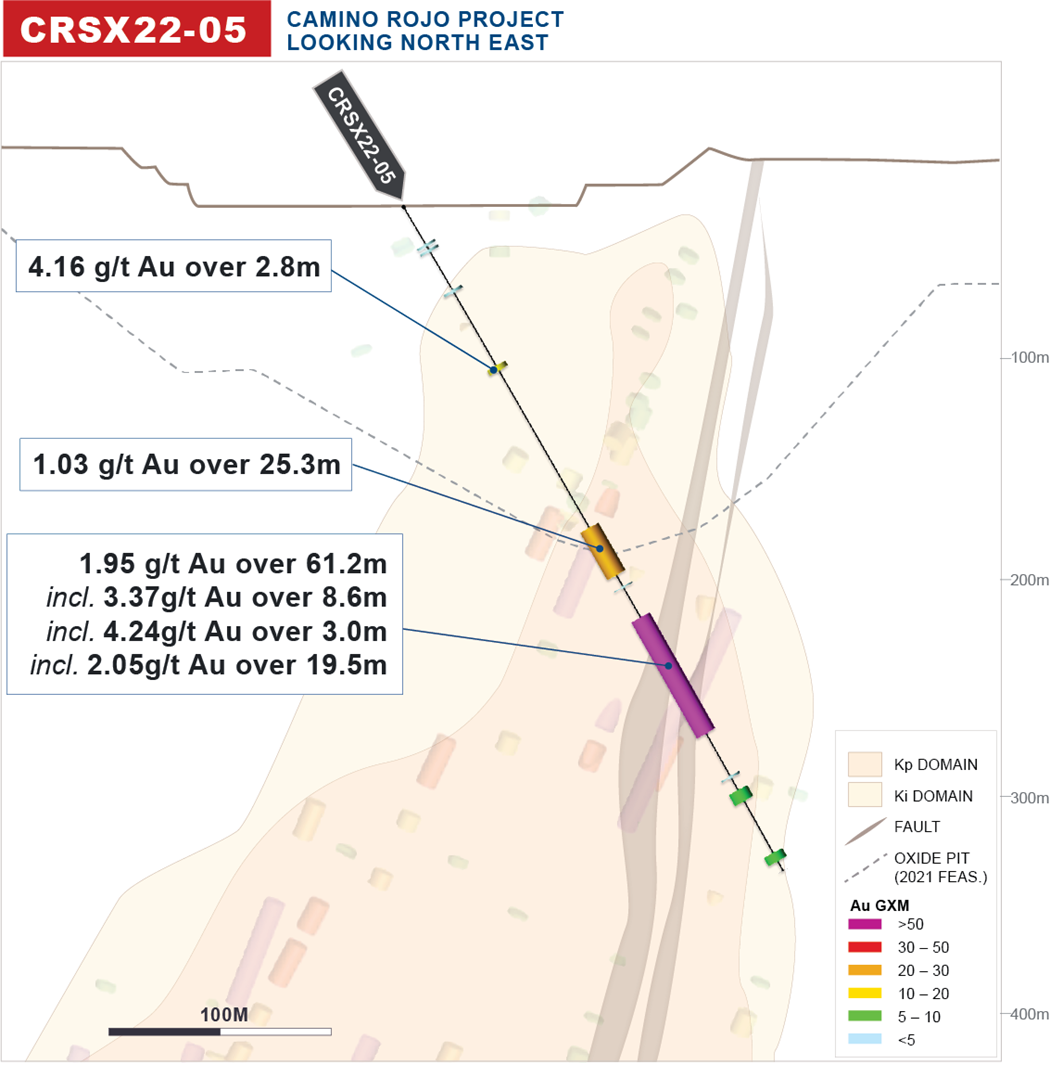
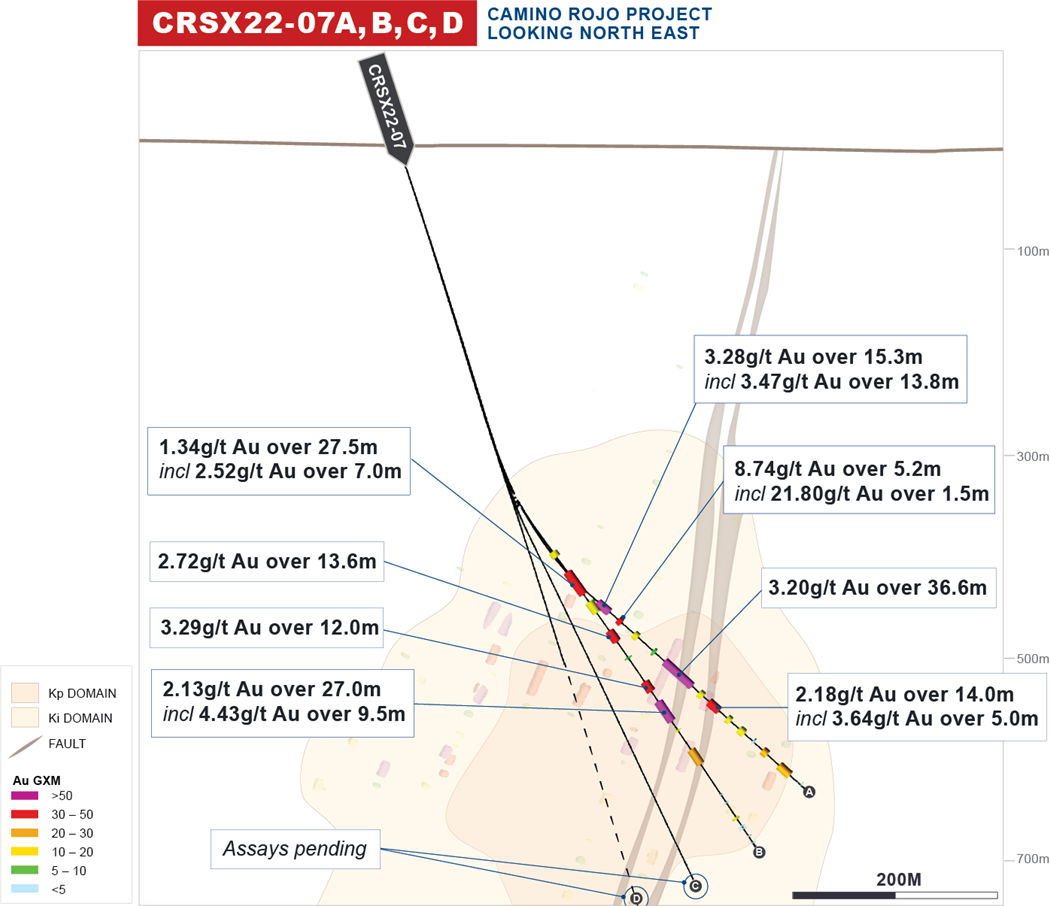
Camino Rojo Regional Program:
Program: RC drilling of high priority, near-mine target areas including along the Camino Rojo mine trend is underway, with 40% of the program completed. Discovery of new deposits is the objective, and this could include oxide deposits that support mine life extension or additional sulphide deposits that expand the already impressive sulphide endowment.
Results: Drilling in the second quarter has focused on the Centro and Represa Sur targets, in addition to the SF, SFSW, CRSW, and Las Catas targets (Figure 4). Anomalous gold results (up to 0.31 g/t Au over 1.5m or 0.11 g/t Au over 6.0m) with associated pathfinder elements such as antimony (up to 2720 ppm over 1.5m) generated along the Camino Rojo Mine Trend at Centro. Multiple regional targets will be tested in the second half of 2022 and beyond, pending receipt of necessary drill permits.
Next Steps: In the second half of 2022, soil sampling, drone mag, and IP will be conducted over the northeast mine trend area to refine exploration targets in the El Bocho, Guanamero, and Monterilla areas. Drill testing priority exploration targets in these areas, including those with significant and anomalous gold results in the 2021 regional rotary air blast (“RAB”) drill holes at the Guanamero target area (including 1.94 g/t Au over 3 m in hole RABCR21-106b and 0.13 g/t Au over 17 m in RABCR21-105B (see March 14, 2022, Press Release – Orla Mining Commences Near Mine and Regional Exploration at Camino Rojo and Cerro Quema for further details), is expected to be completed during the remainder of the year.
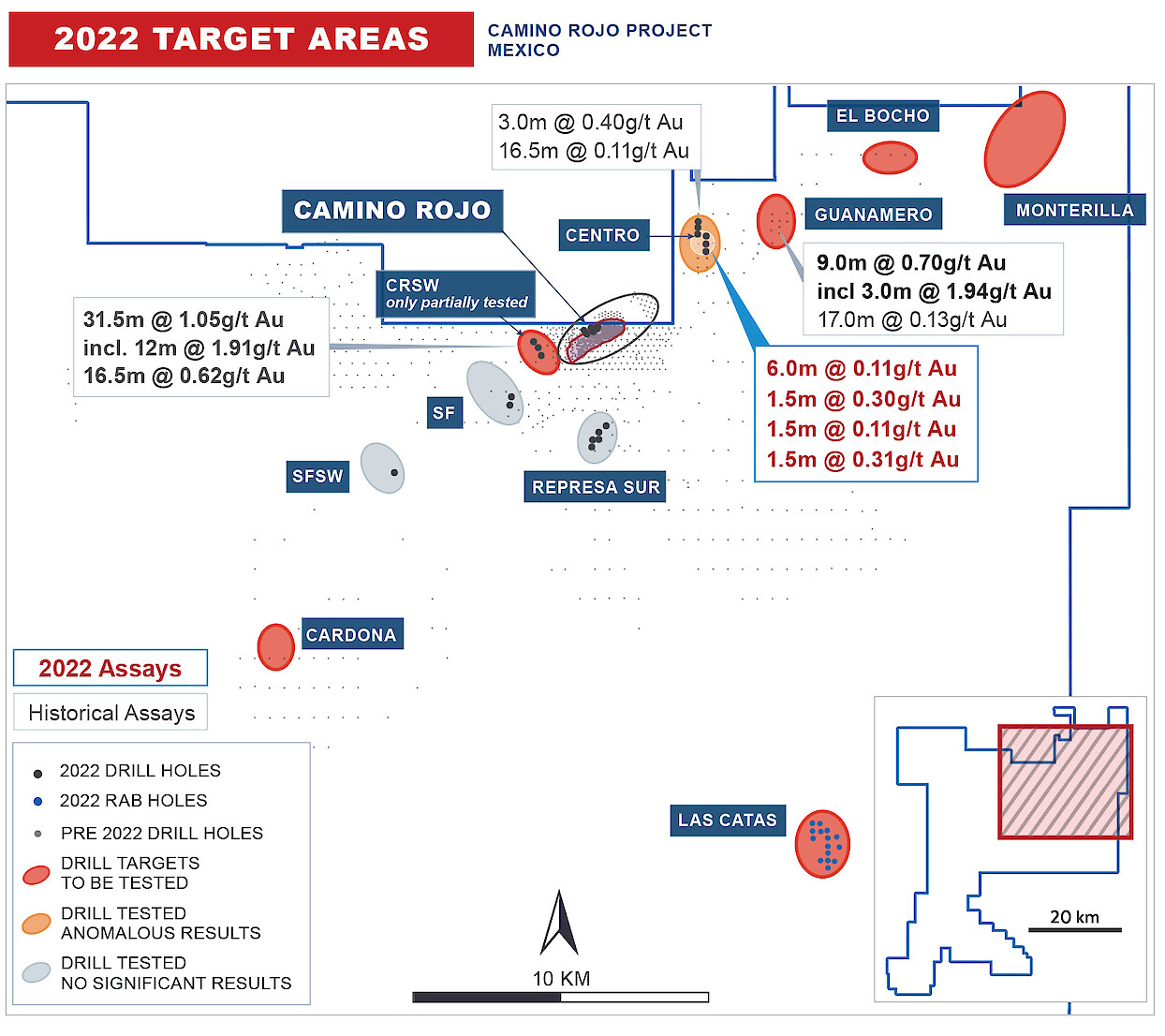
For additional information on previous drill results on Guanamero, please refer to the Company’s press release dated March 14, 2022 – Orla Mining Commences Near Mine and Regional Exploration at Camino Rojo and Cerro Quema. All other previous drill results presented in Figure 4 are historical in nature and are not treated by the Company as current. Such results were completed by Goldcorp Inc., a prior owner of the Camino Rojo Project.
CERRO QUEMA (PANAMA) EXPLORATION:
In the second quarter, drilling at Cerro Quema focused on the La Prieta and La Pelona targets. Both target areas returned significant Au and anomalous Cu results and follow-up drilling in both areas is expected for early 2023. Diamond drilling at Cerro Quema will continue through the second half of the year, with drill rigs moving to metallurgical, infill, and expansion drilling at Caballito and Quemita.
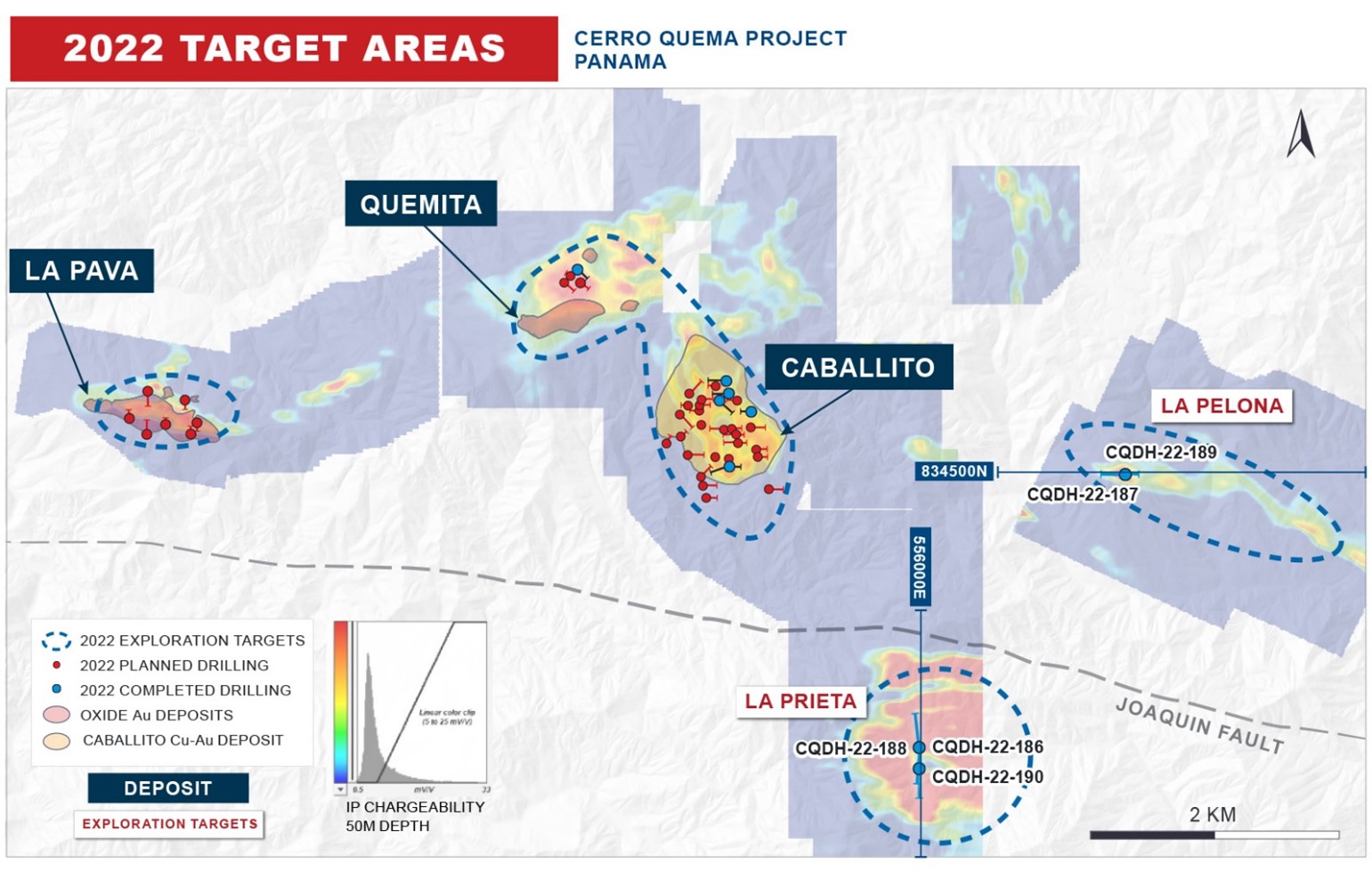
La Pelona:
Program: Two diamond drill core holes, totalling 540 metres, have been completed at La Pelona. These two drill holes followed up on historical diamond drill holes that returned lower grade oxide gold intersections of 0.15 to 0.41 g/t over large drill intervals ranging from 76 to 144 metres.
Results and Next Steps: Both recent drill holes intersected styles of alteration and sulphide mineralization similar to that observed at Caballito and suggests potential for additional oxide and sulphide mineralization. Drilling results are illustrated in Figure 6 and assay results are presented in Table 4, drill highlights include:
- Hole CQDH-22-187: 0.27 g/t Au over 113.7m (from 5.2m in oxide)
- Hole CQDH-22-189: 0.46 g/t Au over 104.8m, incl. 0.70 g/t Au over 46.5m (from 18.3m in oxide)
The near surface oxide drill results support the exploration model and indicate the potential to add oxide mineralization at the Cerro Quema project.
Additional drilling is being considered for early 2023 with the goal of testing and expanding Au-Cu mineralization at La Pelona.
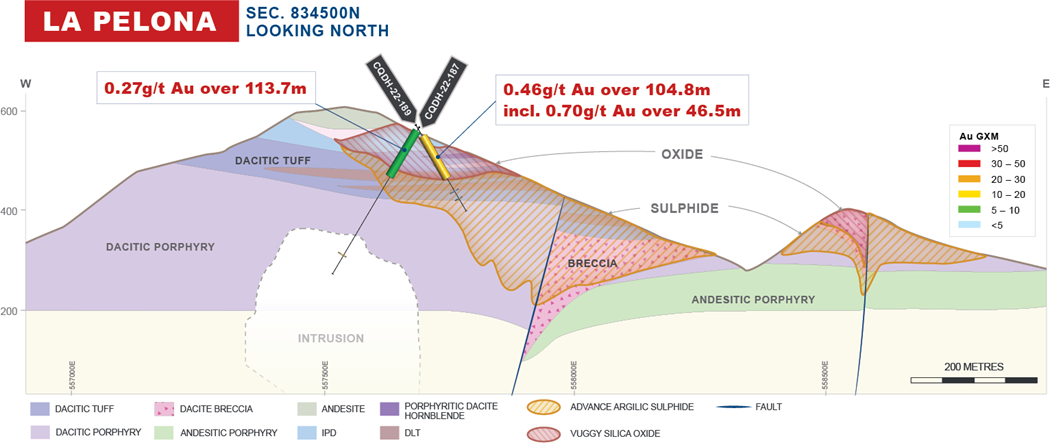
La Prieta:
Program: Three diamond drill core holes, totalling 1,494 metres have been completed at La Prieta. These first drill holes tested a large (1.2 km2) soil, rock and geophysical IP anomalies consistent with intrusion-related Au-Cu mineralization.
Results and Next Steps: All three holes intercepted anomalous gold-copper mineralization and significant Au intercepts in hole 188. Mineralization is associated with pyrite, chalcopyrite, and bornite in quartz stockworks, quartz veins and hydrothermal magnetite-pyrite matrix breccias. This mineralization provides strong indicators of high potential for an Au-Cu intrusion-related system discovery. Drilling results are illustrated in Figure 7 and assay results are presented in Table 4. Drill highlights include:
- Hole CQDH-22-186: 0.50 g/t Au and 0.32% Cu over 10.5m
- Hole CQDH-22-188: 1.01 g/t Au over 13.5m, 27.3 g/t Au and 0.91% Cu over 0.75m
These first drill results demonstrate that La Prieta mineralized intrusive system has generated anomalous to significant gold grades over significant widths (e.g., 0.23 g/t Au over 35.95m, 0.31 g/t Au over 17.75m, 1.01 g/t Au over 13.5m) as well as narrow high-grade intervals (e.g., 27.3 g/t Au and 0.91% Cu over 0.75m). The results justify follow-up drilling over the target area.
Additional drilling will be considered for early 2023 to continue to test and evaluate the economic potential of Au-Cu mineralization at La Prieta.
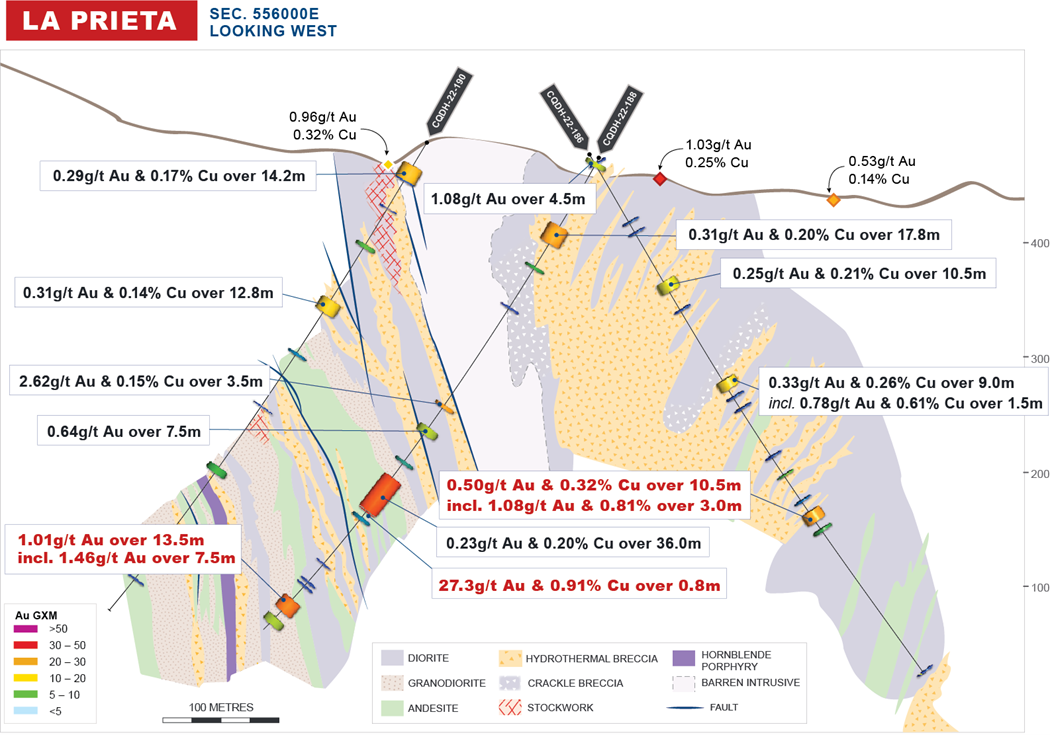
SOUTH RAILROAD (NEVADA, USA) EXPLORATION:
Orla recently acquired two projects in Nevada through its acquisition of GSV: The South Railroad Project, located on the Carlin Trend, and the Lewis Project, located on the Battle Mountain Trend (Figure 8).
Program: Through the remainder of the year, Orla will continue with GSV’s 2022 planned program of resource expansion and exploration drilling at key targets on the South Railroad Project. The Company will also commence an additional 5,000 metre RC and core drill program at South Railroad for an additional $1.5 million, bringing the total 2022 planned direct drilling cost spending to $3.0 million across 11,370 metres of drilling. The current and primary objectives are to upgrade and increase oxide resources at the Pinion SB, LT, POD, Sweet Hollow, Jasperoid Wash, and Dixie targets (Figure 8).
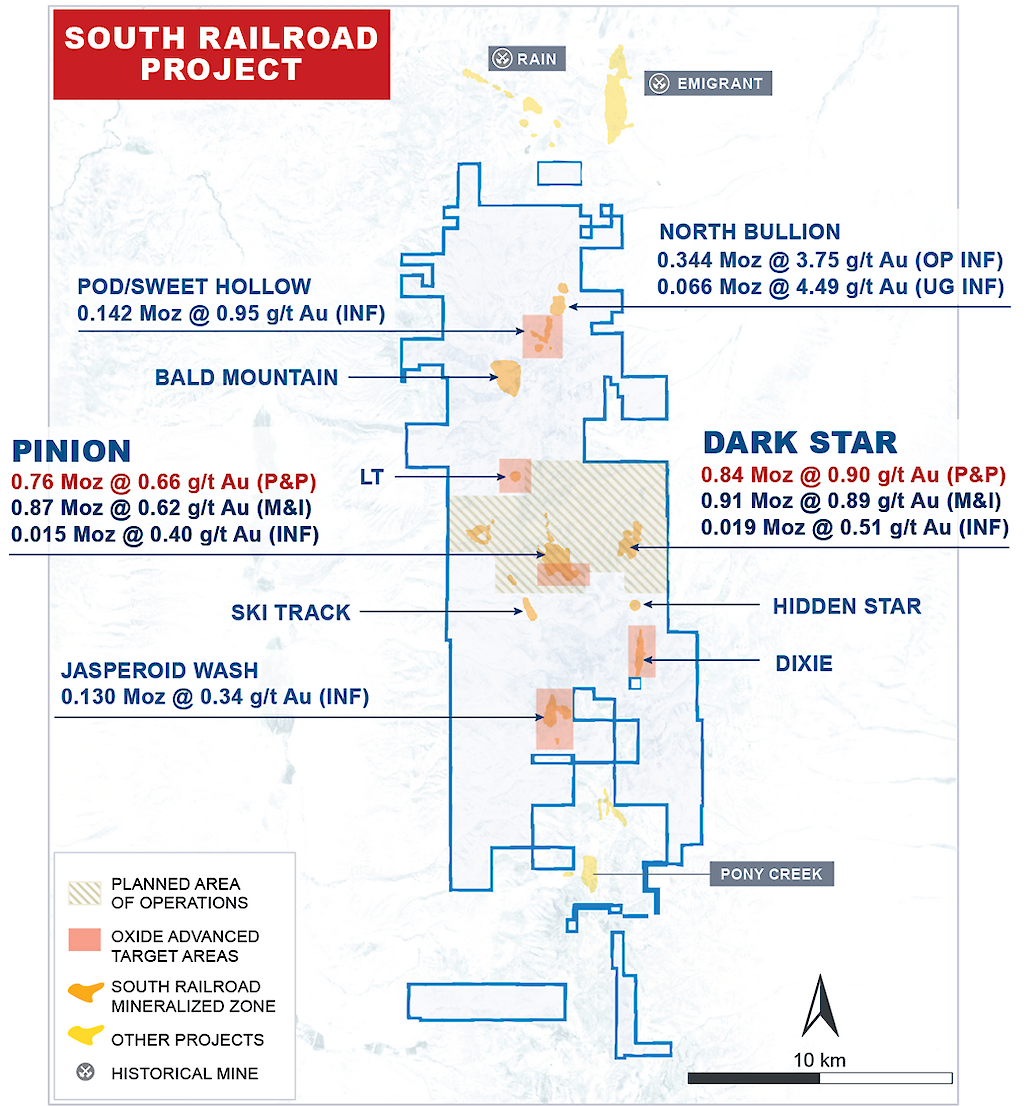
2022 EXPLORATION BUDGET:
The initial 2022 exploration budget totalled $15 million, with $10 million allocated to Mexico and $5 million allocated to Panama. Supported by the recent exploration success and following the completion of the acquisition of Gold Standard Ventures, Orla will increase the 2022 spending to $18.0 million.
Qualified Person Statement
The scientific and technical information in this news release has been reviewed and approved by Mr. Sylvain Guerard, P Geo., SVP Exploration of the Company, who is the Qualified Person as defined under the definitions of National Instrument 43-101 (“NI 43-101”).
To verify the information related to the 2022 drilling programs at the Camino Rojo and Cerro Quema properties, Mr. Guerard has visited the properties in the past year; discussed logging, sampling, and sample shipping processes with responsible site staff; discussed and reviewed assay and QA/QC results with responsible personnel; and reviewed supporting documentation, including drill hole location and orientation and significant assay interval calculations.
Quality Assurance / Quality Control – 2022 Drill Program
Camino Rojo
All gold results at Camino Rojo were obtained by ALS Minerals (Au-AA23) using fire assay fusion and an atomic absorption spectroscopy finish. All samples are also analyzed for multi-elements, including silver, copper, lead and zinc using an Aqua Regia (ME-ICP61) method at ALS Laboratories in Canada. If samples are returned with base metal values in excess of 1% by ICP analysis, samples are re-run with AA46 aqua regia and atomic absorption analysis. Drill program design, Quality Assurance/Quality Control and interpretation of results are performed by qualified persons employing a Quality Assurance/Quality Control program consistent with NI 43-101 and industry best practices. Standards were inserted at a frequency of one in every 50 samples, and blanks were inserted at a frequency of one in every 50 samples for Quality Assurance/Quality Control purposes by the Company as well as the lab. ALS Laboratories is independent of Orla. There are no known drilling, sampling, recovery, or other factors that could materially affect the accuracy or reliability of the drilling data at Camino Rojo.
Cerro Quema
All gold results for Cerro Quema were obtained by ALS Minerals (Au-AA23) using fire assay fusion and an atomic absorption spectroscopy finish. All samples are also analyzed for multi-elements, including copper, using an Aqua Regia (ME-ICP41) method at ALS Laboratories in Peru. If samples are returned with base metal values in excess of 1% by ICP analysis, samples are re-run with AA46 aqua regia and atomic absorption analysis. If samples are returned with gold metal values in excess of 10 g/t by fire assay and atomic absorption spectroscopy finish, samples are re-run with Au-GRA21 gravimetric analysis and atomic absorption analysis. Drill program design, Quality Assurance/Quality Control and interpretation of results are performed by qualified persons employing a Quality Assurance/Quality Control program consistent with NI 43-101 and industry best practices. Standards were inserted at a frequency of one in every 50 samples, and blanks were inserted at a frequency of (at random) one in every 70 samples for Quality Assurance/Quality Control purposes by the Company as well as the lab. ALS Laboratories is independent of Orla. There are no known drilling, sampling, recovery, or other factors that could materially affect the accuracy or reliability of the drilling data at Cerro Quema.
South Railroad Project Technical Information
With respect to the South Railroad Project, the mineral reserve estimate for: (i) Dark Star consists of 283 koz gold of proven reserves (6,911 k tonnes at 1.27 g/t) and 557 koz gold of probable reserves (22,247 k tonnes at 0.78 g/t); and (ii) Pinion consists of 50 koz gold of proven reserves (2,049 k tonnes at 0.76 g/t) and 714 koz gold of probable resources (33,992 k tonnes at 0.65 g/t). The mineral resource estimate for (i) Dark Star consists of 288 koz gold of measured resources (7,225 k tonnes at 1.24 g/t), 625 koz gold of indicated resources (24,567 k tonnes at 0.79 g/t) and 19 koz gold of inferred resources (1,176 k tonnes at 0.51 g/t); (ii) Pinion consists of 55 koz gold of measured resources (2,336 k tonnes at 0.73 g/t), 816 koz gold of indicated resources (41,193 k tonnes at 0.62 g/t) and 15 koz gold of inferred resources (1,178 k tonnes at 0.40 g/t); (iii) Jasperoid Wash consists of 130 koz gold of inferred resources (11,939 k tonnes at 0.34 g/t); (iv) POD / Sweet Hollow consists of 142 koz gold of inferred resources (4,654 k tonnes at 0.95 g/t); (v) North Bullion Open Pit consists of 344 koz gold of inferred resources (2,849 k tonnes at 3.75 g/t); and (vi) North Bullion Underground consists of 66 koz gold of inferred resources (457 k tonnes at 4.49 g/t). For additional detail, see the South Railroad Feasibility Study (as defined below). Mineral resources are inclusive of mineral reserves.
About Orla Mining Ltd.
Orla is operating the Camino Rojo Oxide Gold Mine, a gold and silver open-pit and heap leach mine, located in Zacatecas State, Mexico. The property is 100% owned by Orla and covers over 160,000 hectares. The technical report for the 2021 Feasibility Study on the Camino Rojo oxide gold project entitled “Unconstrained Feasibility Study NI 43-101 Technical Report on the Camino Rojo Gold Project – Municipality of Mazapil, Zacatecas, Mexico” dated January 11, 2021, is available on SEDAR and EDGAR under the Company’s profile at www.sedar.com and www.sec.gov, respectively. Orla also owns 100% of Cerro Quema located in Panama which includes a gold production scenario and various exploration targets. Cerro Quema is a proposed open pit mine and gold heap leach operation. The technical report for the Pre-Feasibility Study on the Cerro Quema oxide gold project entitled “Project Pre-Feasibility Updated NI 43-101 Technical Report on the Cerro Quema Project, Province of Los Santos, Panama” dated January 18, 2022 (the “Cerro Quema Pre-Feasibility Study”), is available on SEDAR and EDGAR under the Company’s profile at www.sedar.com and www.sec.gov, respectively. Orla also owns 100% of the South Railroad Project, a feasibility-stage, open pit, heap leach project located on the Carlin trend in Nevada. The technical report for the 2022 Feasibility Study entitled “South Railroad Project, Form 43-101F1 Technical Report Feasibility Study, Elko County, Nevada” dated March 23, 2022 (the “South Railroad Feasibility Study”), is available on SEDAR and EDGAR under Gold Standard Venture’s profile at www.sedar.com and www.sec.gov, respectively. The technical reports are available on Orla’s website at www.orlamining.com.
For further information, please contact:
Jason Simpson
President & Chief Executive Officer
Andrew Bradbury
Vice President, Investor Relations & Corporate Development
www.orlamining.com
[email protected]
Forward-looking Statements
This news release contains certain “forward-looking information” and “forward-looking statements” within the meaning of Canadian securities legislation and within the meaning of Section 27A of the United States Securities Act of 1933, as amended, Section 21E of the United States Exchange Act of 1934, as amended, the United States Private Securities Litigation Reform Act of 1995, or in releases made by the United States Securities and Exchange Commission, all as may be amended from time to time, including, without limitation, statements regarding the 2022 drill program, including the expected timing, benefits and results thereof, and statements regarding potential mineralization at the Company’s projects. Forward-looking statements are statements that are not historical facts which address events, results, outcomes or developments that the Company expects to occur. Forward-looking statements are based on the beliefs, estimates and opinions of the Company’s management on the date the statements are made and they involve a number of risks and uncertainties. Certain material assumptions regarding such forward-looking statements were made, including without limitation, assumptions regarding the price of gold, silver, and copper; the accuracy of mineral resource and mineral reserve estimations; that there will be no material adverse change affecting the Company or its properties; that all required approvals will be obtained, including concession renewals and permitting; that political and legal developments will be consistent with current expectations; that currency and exchange rates will be consistent with current levels; and that there will be no significant disruptions affecting the Company or its properties. Consequently, there can be no assurances that such statements will prove to be accurate and actual results and future events could differ materially from those anticipated in such statements. Forward-looking statements involve significant known and unknown risks and uncertainties, which could cause actual results to differ materially from those anticipated. These risks include, but are not limited to: uncertainty and variations in the estimation of mineral resources and mineral reserves, including risks that the interpreted drill results may not accurately represent the actual continuity of geology or grade of the deposit, bulk density measurements may not be representative, interpreted and modelled metallurgical domains may not be representative, and metallurgical recoveries may not be representative; the Company’s reliance on Camino Rojo and risks associated with its start-up phase; financing risks and access to additional capital; risks related to natural disasters, terrorist acts, health crises and other disruptions and dislocations, including by the COVID-19 pandemic; risks related to the Company’s indebtedness; success of exploration, development, and operation activities; foreign country and political risks, including risks relating to foreign operations and expropriation or nationalization of mining operations; concession risks; permitting risks; environmental and other regulatory requirements; delays in or failures to enter into a subsequent agreement with Fresnillo Plc with respect to accessing certain additional portions of the mineral resource at Camino Rojo and to obtain the necessary regulatory approvals related thereto; the mineral resource estimations for Camino Rojo being only estimates and relying on certain assumptions; the Layback Agreement with Fresnillo Plc remaining subject to the transfer of surface rights; delays in or failure to get access from surface rights owners; risks related to guidance estimates and uncertainties inherent in the preparation of feasibility and pre-feasibility studies, including but not limited to, assumptions underlying the production estimates not being realized, changes to the cost of production, variations in quantity of mineralized material, grade or recovery rates, geotechnical or hydrogeological considerations during mining differing from what has been assumed, failure of plant, equipment or processes, changes to availability of power or the power rates, ability to maintain social license, changes to exchange, interest or tax rates, cost of labour, supplies, fuel and equipment rising, changes in project parameters, delays, and costs inherent to consulting and accommodating rights of local communities; uncertainty in estimates of production, capital, and operating costs and potential production and cost overruns; the fluctuating price of gold, silver, and copper; global financial conditions; uninsured risks; competition from other companies and individuals; uncertainties related to title to mineral properties; conflicts of interest; risks related to compliance with anti-corruption laws; volatility in the market price of the Company’s securities; assessments by taxation authorities in multiple jurisdictions; foreign currency fluctuations; the Company’s limited operating history; risks related to the Company’s history of negative operating cash flow; litigation risks; intervention by non-governmental organizations; outside contractor risks; risks related to historical data; unknown labilities in connection with acquisitions; the Company’s ability to identify, complete, and successfully integrate acquisitions; dividend risks; risks related to the Company’s foreign subsidiaries; risks related to the Company’s accounting policies and internal controls; the Company’s ability to satisfy the requirements of the Sarbanes-Oxley Act of 2002; enforcement of civil liabilities; the Company’s status as a passive foreign investment company for U.S. federal income tax purposes; information and cyber security; gold industry concentration; shareholder activism; risks associated with executing the Company’s objectives and strategies, as well as those risk factors discussed in the Company’s most recently filed management’s discussion and analysis, as well as its annual information form dated March 18, 2022, which are available on www.sedar.com and www.sec.gov. Except as required by the securities disclosure laws and regulations applicable to the Company, the Company undertakes no obligation to update these forward-looking statements if management’s beliefs, estimates or opinions, or other factors, should change.
Cautionary Note to U.S. Readers
This news release has been prepared in accordance with Canadian standards for the reporting of mineral resource and mineral reserve estimates, which differ from the previous and current standards of the United States securities laws. In particular, and without limiting the generality of the foregoing, the terms “mineral reserve”, “proven mineral reserve”, “probable mineral reserve”, “inferred mineral resources,”, “indicated mineral resources,” “measured mineral resources” and “mineral resources” used or referenced herein and the documents incorporated by reference herein, as applicable, are Canadian mineral disclosure terms as defined in accordance with Canadian National Instrument 43-101 — Standards of Disclosure for Mineral Projects (“NI 43-101”) and the Canadian Institute of Mining, Metallurgy and Petroleum (the “CIM”) — CIM Definition Standards on Mineral Resources and Mineral Reserves, adopted by the CIM Council, as amended (the “CIM Definition Standards”).
For United States reporting purposes, the United States Securities and Exchange Commission (the “SEC”) has adopted amendments to its disclosure rules (the “SEC Modernization Rules”) to modernize the mining property disclosure requirements for issuers whose securities are registered with the SEC under the Exchange Act, which became effective February 25, 2019. The SEC Modernization Rules more closely align the SEC’s disclosure requirements and policies for mining properties with current industry and global regulatory practices and standards, including NI 43-101, and replace the historical property disclosure requirements for mining registrants that were included in SEC Industry Guide 7. Issuers were required to comply with the SEC Modernization Rules in their first fiscal year beginning on or after January 1, 2021. As a foreign private issuer that is eligible to file reports with the SEC pursuant to the multi-jurisdictional disclosure system, the Corporation is not required to provide disclosure on its mineral properties under the SEC Modernization Rules and will continue to provide disclosure under NI 43-101 and the CIM Definition Standards. Accordingly, mineral reserve and mineral resource information contained or incorporated by reference herein may not be comparable to similar information disclosed by United States companies subject to the United States federal securities laws and the rules and regulations thereunder.
As a result of the adoption of the SEC Modernization Rules, the SEC now recognizes estimates of “measured mineral resources”, “indicated mineral resources” and “inferred mineral resources.” In addition, the SEC has amended its definitions of “proven mineral reserves” and “probable mineral reserves” to be “substantially similar” to the corresponding CIM Definition Standards that are required under NI 43-101. While the SEC will now recognize “measured mineral resources”, “indicated mineral resources” and “inferred mineral resources”, U.S. investors should not assume that all or any part of the mineralization in these categories will be converted into a higher category of mineral resources or into mineral reserves without further work and analysis. Mineralization described using these terms has a greater amount of uncertainty as to its existence and feasibility than mineralization that has been characterized as reserves. Accordingly, U.S. investors are cautioned not to assume that all or any measured mineral resources, indicated mineral resources, or inferred mineral resources that the Company reports are or will be economically or legally mineable without further work and analysis. Further, “inferred mineral resources” have a greater amount of uncertainty and as to whether they can be mined legally or economically. Therefore, U.S. investors are also cautioned not to assume that all or any part of inferred mineral resources will be upgraded to a higher category without further work and analysis. Under Canadian securities laws, estimates of “inferred mineral resources” may not form the basis of feasibility or pre-feasibility studies, except in rare cases. While the above terms are “substantially similar” to CIM Definitions, there are differences in the definitions under the SEC Modernization Rules and the CIM Definition Standards. Accordingly, there is no assurance any mineral reserves or mineral resources that the Company may report as “proven mineral reserves”, “probable mineral reserves”, “measured mineral resources”, “indicated mineral resources” and “inferred mineral resources” under NI 43-101 would be the same had the Company prepared the reserve or resource estimates under the standards adopted under the SEC Modernization Rules or under the prior standards of SEC Industry Guide 7.
Original Article: https://orlamining.com/news/orla-mining-advances-exploration-growth-pipeline/
